CPMI Welcomes S. B. Bhatt, Vaccum Division Head of Tokamak ADITYA, from the Institute for Plasma Research in India. Bhatt will be giving a seminar entitled “Wall Conditioning in Tokamak Aditya,” on Monday afternoon from 2 PM – 3 PM in Rm. 103 Talbot Lab.
Two of CPMI’s PhD students did the Center proud at the recent Symposium on Fusion Engineering (SOFE) Conference in Chicago. Both students were nominated for the SOFE student paper award. Wenyu was the eventual winner of the award, with a $500 cheque and plaque while Soonwook was runner up.
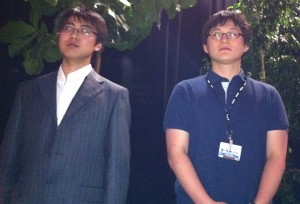
Wenyu Xu (Left) and Soonwook Jung (Right) at the awards ceremony, SOFE conference dinner.
Wenyu presented a paper on his LiMIT concept. LiMIT is a device that is being developed using liquid lithium metal to be able to absorb the high heat fluxes in the divertor of a Fusion reactor and be able to pump this away while replenishing itself, thus effectively eliminating damage to the divertor itself.
While Soonwook’s presentation was in his recent investigations on lithium vapor shielding for with molybdenum in DEVeX. The DEVeX device is able to simulate an high energy strike using a theta pinch and can obtain high plasma temperatures and densities to simulate the edge of a fusion plasma.

Soonwook Jung receiveing his runners-up certificate.
Both students gave presentations to a panel at the conference and it was eventually decided that Wenyu had the best paper at the conference. Wenyu received the award at the SOFE Conference dinner on Wednesday night.
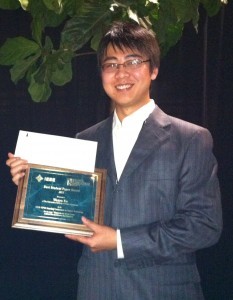
Wenyu with his prize for the best Student Paper for SOFE.
Everyone at CPMI are proud of the work that Wenyu and Soonwook have done and this wonderful recognition of their and the CPMI’s work in fusion.
Zihao Ouyang et al 2011 J. Phys. D: Appl. Phys. 44 265202
Laser-assisted plasma coating at atmospheric pressure: production of yttria-stabilized zirconia thermal barriers
Zihao Ouyang, Liang Meng, Priya Raman, Tae S Cho and D N Ruzic
A laser-assisted plasma-coating technique at atmospheric pressure (LAPCAP) has been investigated. The electron temperature, electron density and gas temperature of the atmospheric-pressure plasma have been measured using optical emission spectroscopy (OES). LAPCAP utilizes laser ablation of 3 mol% yttria-stabilized zirconia into an atmospheric helium/nitrogen plasma to deposit thermal barrier coatings on a nickel-based substrate. The deposited film shows columnar structures similar to films prepared by high-vacuum deposition methods, such as physical vapour deposition and conventional pulsed-laser deposition. However, the LAPCAP films have smaller columns and higher porosity, compared with the films deposited by other techniques. The morphology and characteristics of the films have been analysed by scanning electron microscope, focused ion beam and x-ray diffraction.
Link to Full Article.
Further great news with this article is that one of the images will be featured on the cover of the Journal in the edition its published. Congratulations to everyone involved!
Former CPMI acting-director Dr. Martin Neumann was recently honored by the University of Illinois Alumni Association for the 2011 University of Illinois Loyalty Award for Exceptional Alumni Service. Dr. Neumann has shown enthusiastic support for the University throughout his career and continues to be actively involved in alumni activities.
Click here for the NPRE story.
Congratulations Dr. Neumann!
In order to get undergraduate and even high school students interested in plasma science, the CPMI often gives tours to highlight our research projects. As part of these tours, plasma demonstrations are shown so that students get a better understanding of the power of plasma!
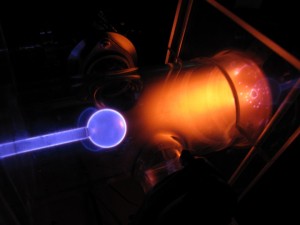
DC Glow Chamber
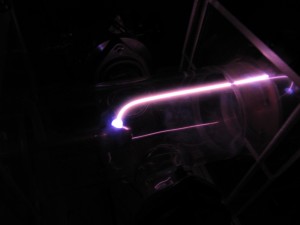
Arc mode in DC Glow Chamber
On the 29th April, 2011, six new Bliss Professors of of Engineering were announced by the College of Engineering at the University of Illinois. CPMI’s director, Prof. David Ruzic was amongst this prestigious group, which include: Stephen Boppart, Kent Choquette, Phillipe Geubelle, Jiawei Han and Albert Valocchi. It is a wonderful recognition and reward for the hard work that David has put in over the years.
CPMI would like to Congratulate David and all the other 5 Bliss Professors that have been announced.
To read the full announcement, please click here. Below is a biography on David Ruzic:
Ru zic joined the Department of Nuclear, Plasma and Radiological Engineering as an assistant professor in 1984. Today, he directs the Center for Plasma Materials Interactions which studies particle-surface interactions relevant to fusion power and materials processing systems through a combination of computational and experimental means.
zic joined the Department of Nuclear, Plasma and Radiological Engineering as an assistant professor in 1984. Today, he directs the Center for Plasma Materials Interactions which studies particle-surface interactions relevant to fusion power and materials processing systems through a combination of computational and experimental means.
A leading researcher in the creation of EUV (extreme ultraviolet) lithography sources and associated equipment for creating semiconductor chips at the 22 nm node, Ruzic has led all College of Engineering faculty in sole-PI direct industry funding, averaging over $1 million per year for the last seven years. Industry partners include Intel, Micron, Ushio (Japan), Xtreme Technologies (Germany), Sematech, ASML (Netherlands), Cymer, Energetiq, Kurt J. Lesker Co., Starfire Industries, Novellus, the SRC, and most recently, the Wrigley Company. Ruzic has three distinct funded Department of Energy grants from the Office of Fusion Energy Sciences, primarily due to his leadership in the development of liquid Li cooled fusion reactor components, a concept he developed that is now employed in at least two of the five operating fusion experimental systems around the world. His work in plasma research has been featured on the Discovery Science Channel’s “Weird Connections” program; he has written two book chapters and 130 refereed publications, and has been granted four patents in the last three years.
About the Bliss Professorships
The Bliss Professor of Engineering is the result of a bequest from the late Helen Eva Bliss in memory of her father, Abel Bliss Jr., who entered the University in 1872 to study civil engineering, but was forced to leave before completing his degree. In June 1874, the University granted him a partial certificate in civil engineering. His business ventures included agriculture and real estate, and by 1929, he was a partner in the land development and oil production company of Bliss & Wetherbee. Mr. Bliss died in the mid-1930s. Miss Bliss graduated from the University of Illinois in 1911 with a degree in Liberal Arts and Sciences. Early in her career, she taught engineering at a Shreveport, Louisiana, high school, and later did clerical work with the Bureau of Aircraft Production in Washington, D.C. From 1936 until her retirement in 1962, she worked for the Washington law firm of Ivins, Phillips & Barker as an executive secretary. A portion of the Bliss bequest went to support the Grainger Engineering Library and Information Center Endowment as well as other projects for “advancing the scholastic activities of the School of Engineering.”
This weekend the center will host tours of the laboratory and experiments for prospective students. Welcome to CPMI!
J. Vac. Sci. Technol. A 29(1) Jan/Feb 2011
Study of plasma dynamics in a modulated pulsed power magnetron discharge using a time-resolved Langmuir probe
L. Meng, A. N. Cloud, S. Jung and D. N. Ruzic
Modulated pulse power MPP technology is a derivative of high power pulsed magnetron sputtering that allows unprecedented user control over the growth process, although the critical time-dependent plasma properties during the power pulse have not been studied until now. Using a MPP plasma generator, pulses of custom voltage waveforms were generated and applied to the cathode of a 36 cm diameter circular planar magnetron. The I-V characteristics of the pulses are separable into distinct discharge stages. A time-resolved triple Langmuir probe was introduced to measure the temporal evolution of the plasma. Typical electron density of 51017 m−3 and electron temperature of 10 eV during the pulse were calculated from measured parameters. Plasma behaviors were observed to closely depend on the pulse waveforms. Various parameters, including pulse current, pulse frequency, pressure, and distance from the target, also affected the electron density and temperature, providing degrees of freedom to optimize the sputtering processes. The effects of each parameter on the pulsed plasma dynamics are discussed and then attributed to mechanisms of electron impact ionization, gas heating, and magnetic confinement.
Link to full article.
Water Air and Soil Pollution (2010) 213:161–16
Lethal Effects of Pulsed High-Voltage Discharge on Marine Plankton and Escherichia coli
C. Y. Hwang, S. Jung, Y. S. Hwang and B. C. Cho
Ballast seawater is considered globally as a major vector for invasions of non-indigenous organisms. Several technologies have been tested for their ability to remove organisms from ballast water. In the present study, we constructed a novel pulsed high-voltage discharge (PHVD) system that could operate in either high current mode with several hundred amperes or shockwave generating mode with relatively lower current in seawater. In laboratory-scale experiments, the PHVD system with shockwave-generating mode was found to be more effective in killing zooplankton (1.9- to 4.0-fold) and phytoplankton (3.3-fold) than high current mode at discharge with 300–500 pulses at 7.1 kV. Further experiments were carried out at different voltages and pulse-numbers to examine effects of the shockwave-generating PHVD system on viabilities of one zooplankton larva, two phytoplankton species, and an indicator bacterium suspended in seawater in a static chamber. For zooplankton, live cells were not detected at discharge with 400 pulses at 13 kV. For phytoplankton, the initial live cells of a dinoflagellate was decreased by 77±0.5%, and the initial chl a concentration of a diatom was decreased by 76±6% at discharge with 700 pulses at 13 kV. For an indicator bacterium Escherichia coli,live cells were not detected at discharges with 200 or 700 pulses at 13 kV. Measurements of ATP content of organisms showed congruent results with those obtained by the above methods, suggesting it may be a rapid method for evaluating treatment efficiency. Though further scale-up studies are necessary, these results suggest that the PHVD system have a high potential for applying to ballast seawater treatment
The CPMI lab this week has taken on a new type of reserach … Movies! A local Champaign Production Company, Tangeant Productions, have taken over one of the Undergrad labs which will be the main scene for their new movie “The Window into Time”.
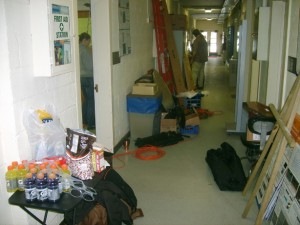
Equipment in the CPMI hall during the production
The Film is about a Professor (Bill Kephart) and his assistant (Stephanie Swearingen) discovering documents on the synthesis of a forbidden and forgotten substance. The dangers of going into the unknown are revealed when supernatural powers are unleashed by the Professor with devastating consequences.

Crew and Actors prepping for a scene
The members of the shoot, which include Thomas Nicol, Chris and Anne Lukeman, Sean O’Leary and Tim Meyers in production with Stephanie Swearingen and Bill Kephart acting, have been very excited to be able to use a real life lab with equipments that is used in actual experiments. members of the CPMI lab have also been involved providing technical consultancy on what some of the equipment does and how it would relate to the movie. On the flip side the film crew have been been able to see how real life experiments are performed, observing (from a distance) the running of CPMI’s DEVeX

Bill Kephart doing a scene from “The Window into Time”
Stay in touch for more info when “The Window into Time” comes out!








